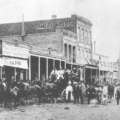The name Ormsby has been a prominent one in Carson City history. You’ve seen it on hotels and street signs, and it seems like it keeps resurfacing over and over. It obviously has important roots in the area to be used so often, and be visible in so many places, but many people don’t know where it came from. Who was Ormsby, and how did his name get everywhere?
 The name comes from Major William Ormsby, one of the town’s first residents and businessmen. He was instrumental in the early roots of Carson City, and his influence would probably be felt even more if his life hadn’t been cut so short.
The name comes from Major William Ormsby, one of the town’s first residents and businessmen. He was instrumental in the early roots of Carson City, and his influence would probably be felt even more if his life hadn’t been cut so short.
I haven’t been able to find much about Ormsby’s early life or how he came by the title Major. I do know that in the 1850s he was an agent for a stagecoach company in Placerville, running the stages over the mountains to Genoa. He later moved to Genoa, and he was there in 1858 when Abraham Curry and his partners came to the area looking to establish themselves.
Curry did eventually start a town in the Eagle Valley, known as Carson City. In the beginning he was giving away land to everybody and anybody who would take it, and Major Ormsby got a large piece right to the southwest of the central plaza. Here in 1859, at the corner of Carson and Second Streets, the Major started building a hotel. This hotel was named the Ormsby House, and in early in 1860 it was open for business, or what little business there was available in the small town at the time. Ormsby I’m sure had grander plans for his part of town, but they never came to pass.
In May of 1860, a way station out by what is today Lake Lahontan was raided by Indians. The raid was done in retaliation for the kidnapping of two young squaws by the residents of the station, and a band of warriors descended on the place, rescuing the girls and killing everyone else inside. The brother of one of the killed men soon came upon the scene, and in a panic set out for Carson City with news of the massacre.
Not knowing about the kidnapping, the few settlers of the Eastern Slope (as the Carson area was known back then) thought they had an Indian uprising on their hands. People from Carson City, Genoa, and Virginia City banded together, 105 members in all, and set out to investigate. Major Ormsby was their leader. They went first to the site of the massacre, then headed north to Pyramid Lake, where they heard a large encampment of Paiutes was gathering. But they never made it to the lake. On the banks of the Truckee River, north of Wadsworth, they were ambushed by a large group of Paiute warriors. Chaos ensued, and many of the vigilantes, who were miners and storekeepers and had no military experience, broke ranks and ran. Major Ormsby tried to keep order, but he was knocked off his horse by an arrow and didn’t survive. In all, only 29 of the party managed to make it back to Virginia City. The Major never got to follow through with the rest of his plans for Carson City. He was buried in Carson City’s Pioneer Cemetery, but later exhumed by his family and taken out of state.
So Ormsby the man was only in the area for a few short years, but his memory lives on in the many places and institutions that have kept his name alive. Next week we’ll take a tour of Carson City and see how many places the name Ormsby can be found.



It is rather strange how even the county where Carson is was named after him for sometime… A short life for such a regailed legacy…
Apparently there is a lot to consider when you research everything that should prove that they hid and rewrote history. William mad all his money coining from 1848 making four dollars on every twenty. what that means is they added tin to the gold at 20%. He had invested in stagecoach transportation, hotels and built Carson City. William was running the coining operation and later when the law was passed making the coiners cast the weight in gold he got out of the business putting all his time in building CARSON CITY.